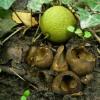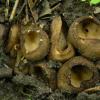
25-08-2014 14:59
 Chris Yeates
Chris Yeates
Boinjour tousThis was found on the underside of a

25-08-2014 16:14
 Hans-Otto Baral
Hans-Otto Baral
Hino idea of the genus or species of this fungus w

19-08-2014 13:49
 Blasco Rafael
Blasco Rafael
Hola, tengo estras muestras recogidas en Angelica
Jafnea semitosta
Zoltan Lukacs,
27-08-2014 22:35
 Hi,
Hi,In Hungary I've found this Ascomycetes in grand mass, under Juglans nigra, Fraxinus excelsior, Acer sp. Earlier I've found it in similar place but from this place 140 kilometers away.
Best wishes
Zoltan
http://forum.index.hu/Article/viewArticle?a=131438957&t=9019811
http://forum.index.hu/Article/viewArticle?a=131388890&t=9019811
http://forum.index.hu/Article/viewArticle?a=131386901&t=9019811



